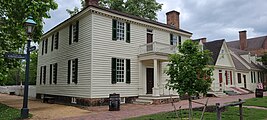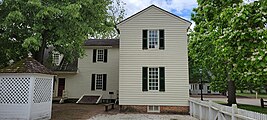Geddy House
| Geddy House | |
|---|---|
 | |
 | |
| Alternative names | James Geddy House |
| General information | |
| Status | Museum |
| Town or city | Williamsburg, Virginia |
| Country | United States |
| Coordinates | 37°16′17″N 76°42′06″W / 37.27137°N 76.70159°W |
| Named for | James Geddy, Jr. |
| Construction started | 1762 |
| Renovated | 1930 |
| Owner | Colonial Williamsburg |
| Technical details | |
| Floor count | Two |
| Website | |
| Colonial Williamsburg Geddy House | |
The Geddy House, also known as the James Geddy House,[1] was built by James Geddy Jr. ca. 1762.[2] One of the oldest houses in Virginia and in Williamsburg,[3] it is located on the Palace Green across from Bruton Parish Church. It is a two-story, central-passage house.[4][5]
History
[edit]James Geddy Jr. was a well-established silversmith in Williamsburg.[6] Advertisements in the late 1760s indicate that Geddy's business sold imported silver and gold items, in addition to fine jewelry and cutlery.[7][8]
In 1762, Geddy built the house at the corner of Duke of Gloucester Street and Palace Green.[9] In addition to serving as the family home, the structure also housed the various business ventures of the Geddy family utilizing a rear entrance as a retail shop.[6][10]
During restorations of Colonial Williamsburg in 1930 and 1967, the entrance porch was replaced, and the house's chimneys were rebuilt above the roof ridge.[4] The house retains much of its original woodwork.[11] Further preservation activities were undertaken in 2002.[12]
Features
[edit]Many aspects of the house's design are not common in other sites in Williamsburg.[13] The house's low-pitched roof and lack of dormers are unusual features, as are the door and balcony above the front porch. The L-shape may have also been adapted to fit the location.[4]
The details of the home include English architecture and Italian variations of Greek and Roman architecture.[4][13] Archeological excavations of the shop site of the house have provided information about eighteenth-century clockmaking in British America.[14]
Gallery
[edit]- Geddy House in Colonial Williamsburg
-
Front view
-
Rear view
-
Outbuilding
References
[edit]- ^ "Historic Site: James Geddy House". www.colonialwilliamsburg.org. Retrieved 2023-08-12.
- ^ Foundation, The Colonial Williamsburg (2011-01-01). Colonial Williamsburg: A Pocket Guide. Colonial Williamsburg. ISBN 978-0-87935-248-6.
- ^ Beney, Peter (1997-11-30). The Majesty of Colonial Williamsburg. Pelican Publishing. ISBN 978-1-4556-0814-0.
- ^ a b c d "James Geddy House". www.slaveryandremembrance.org. Retrieved 2023-08-12.
- ^ "James Geddy House Historical Report Block 19 Building 11 Lots 161 & 162 | Colonial Williamsburg Digital Library". research.colonialwilliamsburg.org. Retrieved 2023-08-12.
- ^ a b "James Geddy Jr.: Silversmithing and Retail Business". www.slaveryandremembrance.org. Retrieved 2023-08-12.
- ^ Stephenson, Mary A. (1953). James Geddy House.
- ^ Morgan, Timothy E. (2004). Williamsburg: A City that History Made. Arcadia Publishing. ISBN 978-0-7385-2473-3.
- ^ pls4e (2019-03-27). "James Geddy House". SAH ARCHIPEDIA. Retrieved 2023-08-12.
{{cite web}}: CS1 maint: numeric names: authors list (link) - ^ "Geddy House and Foundry - site description". www.slaveryandremembrance.org. Retrieved 2023-08-12.
- ^ Foundation, The Colonial Williamsburg (2014-12-08). Colonial Williamsburg: The Official Guide. Colonial Williamsburg. ISBN 978-0-87935-265-3.
- ^ Taylor, Thomas H. (2002). Planned Preservation Project Completion Report James Geddy House.
- ^ a b Yetter, George Humphrey (1988). Williamsburg Before and After: The Rebirth of Virginia's Colonial Capital. Colonial Williamsburg. ISBN 978-0-87935-077-2.
- ^ Hume, Ivor Noël (2001-06-15). A Guide to the Artifacts of Colonial America. University of Pennsylvania Press. ISBN 978-0-8122-1771-1.



